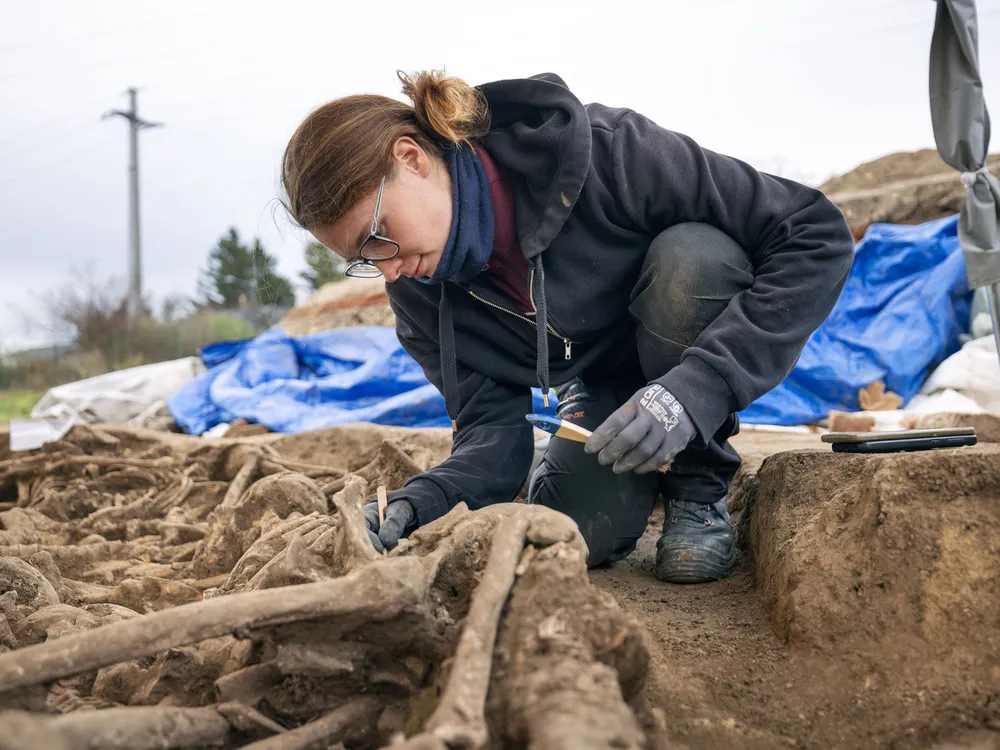Mass Grave From Roman-Era Battle Discovered Beneath a Soccer Field in Vienna
Mass Grave From Roman-Era Battle Discovered Beneath a Soccer Field in Vienna
Archaeologists think that as many as 150 individuals may have been hastily buried at the site, likely after a “catastrophic” military event
Archaeologists suspect that as many as 150 individuals may be buried at the site.
Reiner Riedler / Vienna Museum
Sometime during the first century C.E., a fierce battle took place in what is now Vienna, Austria—likely between Roman soldiers and Germanic warriors. Afterward, the battered bodies of dozens of men were dumped into a pit and covered with dirt.
Now, centuries later, archaeologists are trying to piece together what happened during the “catastrophic” military confrontation, reports Philipp Jenne for the Associated Press.
“Within the context of Roman acts of war, there are no comparable finds of fighters,” says Michaela Binder, an archaeologist with Novetus, the company that led excavations at the site, to the AP. “There are huge battlefields in Germany where weapons were found. But finding the dead, that is unique for the entire Roman history.”
Archaeologists have identified one of the individuals as a Roman warrior.
Reiner Riedler / Vienna Museum
The remains were discovered in October by a construction crew renovating a soccer field in the Simmering neighborhood of Austria’s capital, according to a statement from the Vienna Museum. While working at the site, they found hundreds of entangled human bones in a mass grave.
Archaeologists were brought in to study the mysterious remains, which appear to have been disposed of quickly. Many of the individuals were buried on their sides or stomachs, with their limbs intertwined.
After months of research, archaeologists have now confirmed that at least 129 individuals were buried at the site. They also discovered many dislocated bones, which suggests the total number of victims could be as high as 150.
The discovery of intact human remains from the first centry is unusual, as the Romans cremated their dead through the third century,
A. Slonek / Novetus
Their analysis revealed that all of the victims were men between the ages of 20 and 30. They were all relatively healthy, with good teeth and little evidence of infection, per CNN’s Amarachi Orie. But every individual had suffered some sort of devastating injury—like wounds made by swords, lances, daggers and iron bolts. Some also showed signs of blunt trauma.
The men were likely stripped of their weapons after death, because archaeologists found very few in the grave. They did, however, unearth the remains of a helmet cheek protector, a few pieces of scale armor and nails used on the bottom of leather Roman military shoes called caligae.
They also found an iron dagger and a scabbard that was inlaid with silver wire—a traditional Roman decoration. They dated the dagger to between the middle of the first century and the early part of the second century C.E. Meanwhile, the bones date to between 80 and 230 C.E.
The remains were dumped into a pit quickly and haphazardly.
Reiner Riedler / Vienna Museum
Researchers suspect the fighting took place sometime in the late first century C.E.—probably between 86 and 96 C.E. during the Roman Empire’s Danube campaigns led by the emperor Domitian.
The timeline makes sense in the context of historic texts, which describe battles between the Roman Empire and Germanic tribes toward the end of the first century. In 92 C.E, for instance, records indicate that Germanic troops invaded the Roman Empire near the Danube border and wiped out an entire legion, according to the museum’s statement.
So far, researchers have only been able to identify one of the men as a Roman warrior. They hope to learn more about the victims—including which side they were fighting for—in the future using DNA and strontium isotope analyses, per the AP.
Mass grave mystery: Archaeologists discover 150 Roman-era soldiers in Vienna
Watch on
Military significance aside, archaeologists say the discovery of any human remains from this period is extremely unusual. That’s because the Romans mainly cremated their dead until the third century. The grave gives researchers an unprecedented opportunity to study the “life histories” of individuals who lived during the first century, Binder tells the New York Times’ Eve Sampson.
“For all of middle Europe from the first century, we don’t have any unburned, uncremated human remains,” Binder adds.
The remains could also offer new insights into the history of Vienna itself. Vienna was once “Vindobona,” a modest Roman outpost on the Danube River. But the Romans eventually built up Vindobona into a full-scale military fortress—and perhaps this first-century battle was the catalyst.
“This would place the mass grave in immediate conjunction with the beginning of urban life in present-day Vienna,” says Kristina Adler-Wölfl, who leads Vienna’s urban archaeology department, to CNN.
Get the latest stories in your inbox every weekday.


